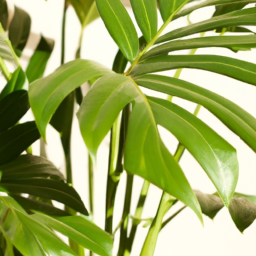
Are you looking to add some greenery to your indoor space? If so, you may want to consider incorporating types of palm houseplants into your home decor. Palms are not only beautiful and versatile plants, but they also have air-purifying qualities that can help improve the air quality in your home. In this blog post, we will explore the different types of palm houseplants that you can choose from to bring a touch of tropical elegance to your living space. Whether you’re a seasoned plant parent or a beginner looking to add some greenery to your home, there’s a palm plant out there for you. So, let’s dive in and discover the wonderful world of palm houseplants!
Popular Types of Palm Houseplants
Introduction
When it comes to adding a touch of tropical elegance to your home, palm houseplants are the perfect choice. With their lush green fronds and graceful appearance, palms can instantly transform any space into a tranquil oasis. There are countless varieties of palm houseplants to choose from, each with its own unique characteristics and care requirements. In this guide, we will explore some of the most popular types of palm houseplants and provide tips on how to care for them.
Types of Palm Houseplants
One of the most popular types of palm houseplants is the Areca palm. Known for its feathery fronds and vibrant green color, the Areca palm is a favorite among indoor plant enthusiasts. This palm thrives in bright, indirect light and requires regular watering to keep its soil moist. With proper care, the Areca palm can grow up to 7 feet tall, making it a stunning focal point in any room.
Another popular choice for palm houseplants is the Majesty palm. With its elegant, arching fronds and glossy green leaves, the Majesty palm adds a touch of sophistication to any space. This palm prefers bright, indirect light and thrives in humid environments. Regular watering is essential to keep the Majesty palm healthy and vibrant.
For those looking for a smaller palm houseplant option, the Parlor palm is an excellent choice. With its compact size and delicate fronds, the Parlor palm is perfect for adding a touch of greenery to small spaces. This palm thrives in low light conditions and requires minimal watering, making it an easy-to-care-for option for beginner plant enthusiasts.
Caring for Palm Houseplants
When it comes to caring for palm houseplants, proper lighting and watering are key. Most palm varieties prefer bright, indirect light, so be sure to place your palm near a window where it can receive plenty of sunlight without being exposed to direct rays. In terms of watering, palms generally prefer to be kept slightly moist but not waterlogged. Allow the top inch of soil to dry out between waterings to prevent root rot.
In addition to proper lighting and watering, palm houseplants benefit from regular feeding and occasional pruning. Use a balanced, water-soluble fertilizer every 2-4 weeks during the growing season to promote healthy growth. Pruning dead or yellowing fronds can help your palm plant maintain its shape and appearance. Be sure to use clean, sharp scissors to avoid damaging the plant.
In conclusion, palm houseplants are a beautiful and versatile addition to any indoor space. With a wide variety of palm species to choose from, there is sure to be a palm plant that suits your style and care preferences. By providing your palm with the right lighting, watering, and care, you can enjoy the beauty of these tropical plants for years to come.

Low-Maintenance Palm Houseplants for Beginners
Introduction
When it comes to choosing houseplants, palm plants are a popular choice due to their tropical and exotic appearance. Not only do they add a touch of greenery to your indoor space, but they are also relatively easy to care for, making them perfect for beginners. In this guide, we will explore some low-maintenance palm houseplants that are ideal for those new to indoor gardening.
Types of Low-Maintenance Palm Houseplants
1. Areca Palm: The Areca Palm, also known as the Butterfly Palm, is a popular choice for indoor spaces due to its feathery and arching fronds. This palm plant thrives in bright, indirect light and requires regular watering to keep the soil moist. It is important to avoid overwatering, as this can lead to root rot. The Areca Palm is relatively low-maintenance and can add a tropical touch to any room.
2. Parlor Palm: The Parlor Palm is a classic choice for beginners, as it is one of the easiest palm plants to care for. This plant thrives in low light conditions and prefers to dry out between waterings. The Parlor Palm is a slow-growing plant that can add a touch of elegance to any indoor space. It is also known for its air-purifying qualities, making it a great choice for those looking to improve indoor air quality.
3. Ponytail Palm: Despite its name, the Ponytail Palm is not a true palm plant but rather a succulent. This plant is known for its unique appearance, with a swollen trunk and long, curly leaves that resemble a ponytail. The Ponytail Palm is extremely low-maintenance and can thrive in a variety of light conditions, from bright indirect light to low light. It is important to allow the soil to dry out between waterings to prevent root rot.
Tips for Caring for Low-Maintenance Palm Houseplants
1. Light: Most palm houseplants thrive in bright, indirect light. Place your palm plant near a window where it can receive plenty of natural light, but be sure to avoid direct sunlight, as this can scorch the leaves.
2. Watering: The key to caring for palm houseplants is to keep the soil consistently moist but not waterlogged. Water your palm plant when the top inch of soil feels dry to the touch, and be sure to allow excess water to drain out of the pot to prevent root rot.
3. Humidity: Palm plants thrive in humid environments, so it is important to provide them with adequate moisture. You can increase humidity by misting your palm plant regularly or placing a humidifier nearby. Alternatively, you can place a tray of water near your plant to create a humid microclimate.
In conclusion, low-maintenance palm houseplants are a great choice for beginners looking to add a touch of tropical flair to their indoor space. By choosing the right palm plant and following these care tips, you can enjoy the beauty of palm plants with minimal effort. So go ahead and bring some greenery into your home with a low-maintenance palm houseplant today!

Indoor Palm Houseplants That Thrive in Low Light Conditions
Areca Palm
Areca palms are popular indoor palm houseplants that are known for their graceful, feathery fronds. These plants thrive in low light conditions, making them perfect for offices or rooms with limited natural light. Areca palms prefer indirect sunlight and can tolerate some shade, making them versatile and easy to care for.
When growing an Areca palm indoors, it is important to keep the soil consistently moist but not soggy. Water the plant when the top inch of soil feels dry to the touch. Additionally, misting the fronds regularly can help increase humidity levels, which the Areca palm thrives in.
To keep your Areca palm healthy and thriving, it is important to fertilize it every 2-3 months during the growing season. Use a balanced, water-soluble fertilizer to provide the plant with the nutrients it needs to grow lush and green fronds. With proper care, your Areca palm can add a touch of tropical elegance to any indoor space.
Parlor Palm
Parlor palms are another popular choice for indoor palm houseplants that thrive in low light conditions. These plants have delicate, arching fronds that give them a graceful appearance. Parlor palms are easy to care for and can tolerate low light, making them ideal for rooms with limited natural light.
When growing a Parlor palm indoors, it is important to keep the soil consistently moist but not waterlogged. Water the plant when the top inch of soil feels dry to the touch, and be sure to drain any excess water from the saucer to prevent root rot. Additionally, misting the fronds regularly can help increase humidity levels and keep the plant healthy.
To keep your Parlor palm looking its best, it is important to fertilize it every 2-3 months during the growing season. Use a balanced, water-soluble fertilizer to provide the plant with the nutrients it needs to thrive. With proper care, your Parlor palm can bring a touch of tropical beauty to any indoor space.
Bamboo Palm
Bamboo palms are a unique and striking choice for indoor palm houseplants that thrive in low light conditions. These plants have slender, bamboo-like stems and lush, green fronds that add a touch of exotic beauty to any indoor space. Bamboo palms are easy to care for and can tolerate low light, making them perfect for offices or rooms with limited natural light.
When growing a Bamboo palm indoors, it is important to keep the soil consistently moist but not waterlogged. Water the plant when the top inch of soil feels dry to the touch, and be sure to drain any excess water from the saucer to prevent root rot. Additionally, misting the fronds regularly can help increase humidity levels and keep the plant healthy.
To keep your Bamboo palm thriving, it is important to fertilize it every 2-3 months during the growing season. Use a balanced, water-soluble fertilizer to provide the plant with the nutrients it needs to grow lush, green fronds. With proper care, your Bamboo palm can add a touch of tropical elegance to any indoor space.
Here’s what we learned
If you’re looking to add some greenery to your home, palm houseplants are a great option to consider. There are a variety of different types of palm houseplants to choose from, each with its own unique characteristics and care requirements. One popular choice is the Areca palm, known for its feathery fronds and ability to thrive in bright, indirect light. Another popular option is the Parlor palm, a low-maintenance plant that can tolerate lower light levels and dry conditions.
For those looking for a statement plant, the Kentia palm is a great choice with its elegant, arching fronds and tall stature. If you’re limited on space, the Ponytail palm is a compact option that adds a touch of whimsy with its unique bulbous trunk. No matter your preference or space constraints, there is sure to be a palm houseplant that fits your needs and adds a touch of tropical flair to your home.
Here are this week’s Top Questions and Answers
Q1. What are some common types of palm houseplants?
A1. Some common types of palm houseplants include Areca Palm, Majesty Palm, Parlor Palm, Kentia Palm, and Lady Palm.
Q2. What is the care routine for palm houseplants?
A2. Palm houseplants thrive in bright, indirect light and require regular watering to keep the soil moist but not waterlogged. It’s also important to occasionally mist the leaves to maintain humidity levels.
Q3. How often should palm houseplants be fertilized?
A3. Palm houseplants should be fertilized every 2-3 months during the growing season (spring and summer) with a balanced houseplant fertilizer diluted to half strength.
Q4. Can palm houseplants tolerate low light conditions?
A4. While palm houseplants prefer bright, indirect light, some varieties like the Parlor Palm can tolerate lower light conditions. However, they may not thrive as well compared to being in a well-lit area.
Q5. How can I prevent common issues like yellowing leaves in palm houseplants?
A5. To prevent yellowing leaves in palm houseplants, ensure they are not overwatered or exposed to drafts. Regularly dusting the leaves and checking for pests can also help maintain the plant’s health.
Dr. Olivia Green is a botanist with over two decades of experience in indoor plant cultivation. She holds a Ph.D. in Plant Biology and has dedicated her career to researching plant behavior in controlled environments. Dr. Green is passionate about helping plant enthusiasts master the art of indoor gardening through her extensive knowledge and practical insights.


